What is an air-source heat pump?
An air-source heat pump extracts warmth from outdoor air, and delivers it to your home. There are two ways that a heat pump can deliver warmth to your home. The first is by blowing warm air through a vent. But the more common way is to pump warm water through radiators or underfloor heating.
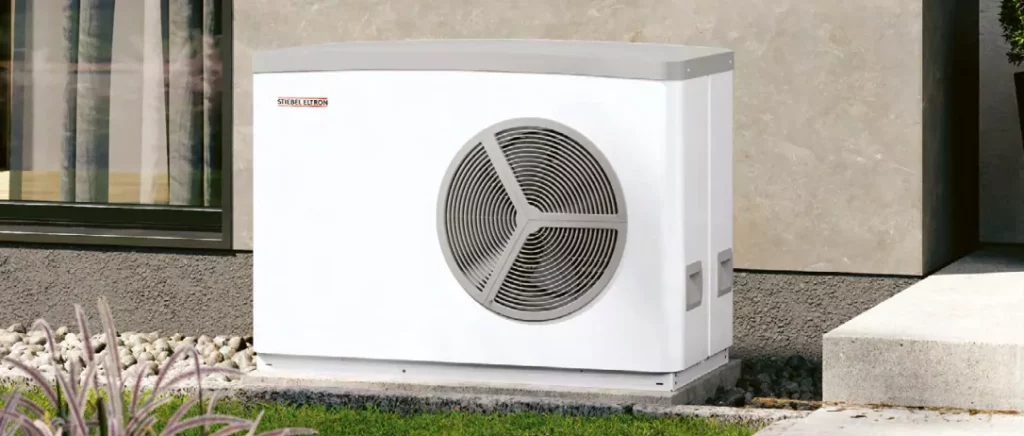
Air-source heat pumps that connect to radiators or underfloor heating are known as air-to-water. Air-to-water heat pumps are the most popular kind in Ireland and will be the main focus of this guide.
The main advantage of air-source heat pumps is their high efficiency. Indeed, while air-source heat pumps use electricity to operate, they can deliver around 4 units of heat for every unit of electricity that they use. That’s why the Irish government are promoting heat pumps so much: Heat pumps are part of the plan to reduce oil and gas burning in Ireland.
High efficiency can also mean lower energy bills for homeowners. And a heat pump can save you a lot on energy bills compared to an oil or gas boiler. But only in a well-insulated home…
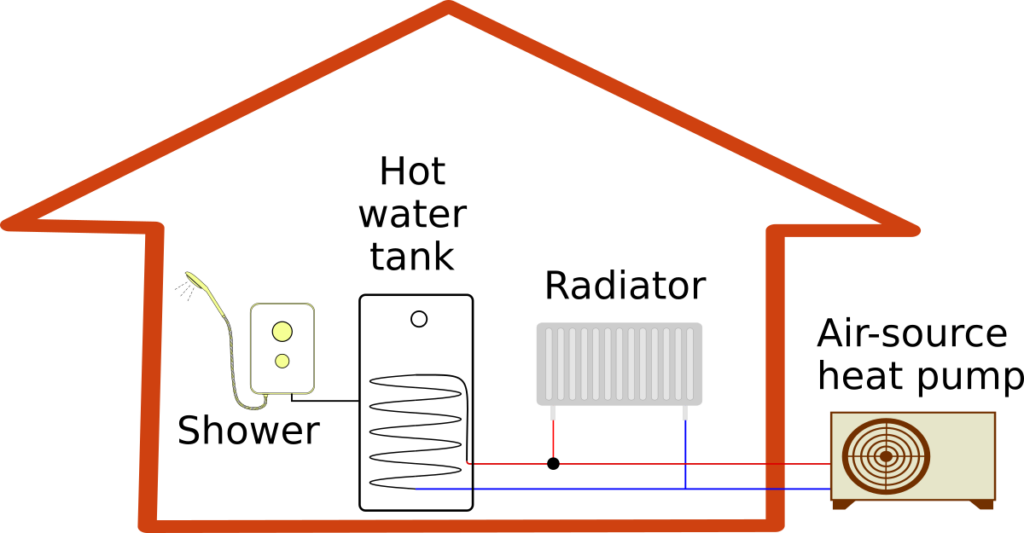
Will an air-source heat pump save you money? (Insulation is key)
That depends!
Being highly efficient, air-source heat pumps can heat a home using far less energy than electricity, oil, or gas. As a rough guide, this can mean savings of around 50% on your energy bills compared to an oil or gas boiler.
However, heat pumps only work well in well-insulated houses. You see, in many (poorly-insulated) Irish houses, the owners typically run the heat only for an hour in the morning and a few hours in the evening. Outside of these times, the house will mostly be cold. And this stop-start operation does not suit heat pumps at all.
Where heat pumps perform great is in a well-insulated house with thermostat-controlled heating. In this context, your heat pump will operate 24 (or close to 24) hours per day. It will keep your home cosy throughout the day and night. And it will do this at a much lower cost than an oil or gas boiler could.
So – the bottom line:
- In a well-insulated home: Yes, a heat pump will save you money
- In a poorly-insulated home: No, a heat pump will not save you money
Assuming your house is well insulated, you can estimate savings with our heat pump savings calculator:
Insulation requirements for air-source heat pumps
So now you know that a home needs to be well-insulated for an air-source heat pump to perform well. But how well-insulated does it need to be? And is your home heat pump-ready?
Well, the only way to determine that for certain is with a heat pump survey. This involves a surveyor checking your property to calculate the “Heat Loss Indicator” (HLI). The HLI measures how quickly your home loses heat. Low scores are better as they indicate that your home retains heat well. You generally need a HLI score under 2 for a heat pump to make sense.
Most home will need all the following to be heat pump-ready (HLI under 2):
- Attic/rafter insulation
- Wall insulation
- Underfloor insulation
- Double glazing (at a minimum)
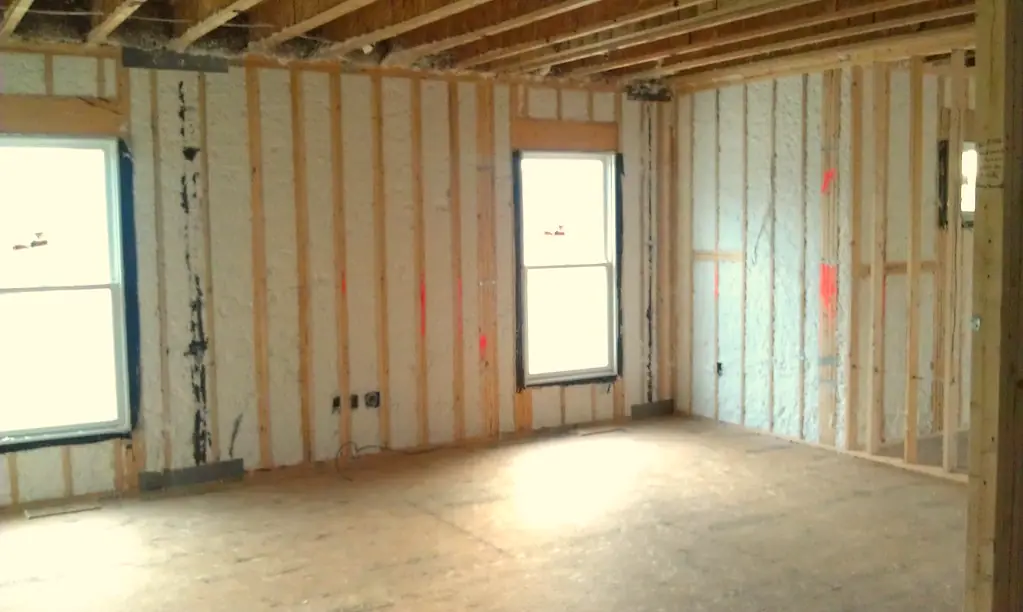
Irish houses built since 2011 should be heat pump ready, even without any insulation retrofits. This is because new building regulations with higher energy efficiency standards entered force that year. Older houses may need insulation upgrades first.
Insulation is so critical to heat pump performance that the SEAI have made adequate insulation a precondition to qualify for heat pump grants. Specifically, you must achieve a HLI under 2 (2.3 in some exceptions) to get a heat pump grant. Here are the details:
Air-source heat pump grants in Ireland
The government are now offering grants up to €6,500 for air-source heat pumps in Ireland. To qualify you must:
- Have a home built before 2021
- Get a Technical Assessment/heat pump survey done
- Achieve a HLI (insulation level) of 2 or lower (2.3 in some exceptions)
- Get the heat pump installed by an SEAI-registered installer
Grant amounts depend on the type of home and the type of heat pumps. With air-to-water heat pumps, the grant rate is €6,500 for houses, and €4,500 for apartments. All dwellings get a grant of €3,500 for air-to-air heat pumps.
Alternatively, you can get a deep retrofit grant which covers multiple home energy upgrades in one go. In this case, the grant amount is 50% of the cost of works, with a maximum payout of €25,000. A deep retrofit is a great option if you want significant insulation upgrades and a heat pump.
Air-source heat pump installation costs in Ireland
A fully-installed air-source heat pump can cost anywhere from €10,000 – €19,000 (ex grants) in Ireland. This includes the cost for hardware, fitting, and radiator upgrades, where required. With an SEAI grant, the net cost falls to €3,500 – €12,500.
Investing in insulation can save you money when it comes to installing your heat pump. That’s because a well-insulated house can manage with a smaller heat pump. Plus, adding insulation makes it more likely that you can use your current radiators (more on that later). But the biggest saving with insulation upgrades will be on the long-term running costs of an air-source heat pump…
Air-source heat pump running costs in Ireland
The electricity consumption of a heat pump depends on three main factors:
House size. This one is simple: The more space to heat, the more it’s going to cost.
Insulation: The better-insulated your house is, the longer it will retain heat. So a heat pump needs less electricity to run, saving you money on bills.
Heat pump efficiency: The more efficient your heat pump, the lower your energy bills. Heat pump efficiency depends on many factors. But the most important ones are flow temperature and brand of heat pump. When it comes to flow temperature, lower is always better. So use underfloor heating or oversized radiators with your heat pump where possible. It’s also worth paying a little extra to get a top heat pump brand with the best efficiency.
The table below gives a rough guide to electricity costs for a heat pump in Ireland. But for a more accurate estimate you can use our heat pump kWh and cost calculator.
| Okay Insulation | Good Insulation | |
| Small (~50 m2 / 1-bed) | € 350 | € 258 |
| Medium (~110 m2 / 3-bed) | € 770 | € 568 |
| Large (~180 m2 / 5-bed) | € 1261 | € 929 |
| X-Large (~230 m2 / Large 5-bed) | € 1611 | € 1187 |
Just like oil and gas boilers, heat pumps need to be serviced once per year. An annual service for a heat pump costs around €70.
Air-source heat pumps vs boilers: Other considerations
Air-source heat pumps are safer than oil and gas boilers. This is because oil and gas boilers can emit lethal carbon monoxide gas when they malfunction. Carbon monoxide is not an risk with air-source heat pumps.
Convenience is another benefit of air-source heat pumps. Specifically, ditching an oil boiler for a heat pump means you’ll never have to arrange heating oil refills again. Likewise, eliminating your gas boiler could mean one less bill to deal with each month.
Finally, switching from oil to an air-source heat pump can free space in your garden. Apart from being ugly, the average oil tank takes up several square metres of garden space. Plenty of room for a garden bench, an apple tree, or a lounge chair.
Is an air-source heat pump worth it in Ireland? (Verdict)
Air-source heat pumps are generally worth it in well-insulated Irish homes. Here, they deliver 24-7 warmth, making for a super-comfortable living environment. And they cost much less to run than oil and gas boilers.
On the other hand, air-source heat pumps are generally a bad idea in poorly-insulated houses. This is because air-source heat pumps are inefficient without adequate insulation. So, installing a heat pump without first insulating your home could result in high bills and a cold house. Certainly not a winning combination!
But what if your home is somewhere in-between? Indeed, so-so insulation is very common in Ireland. Well, if your home has so-so insulation then you’ll need to also weigh up the value that you place on warmth.
You see, upgrading a house with so-so insulation and adding an air-source heat pump has a substantial upfront cost. And it may take a long time to recover that cost via lower energy bills. But the improvement in thermal comfort is immediate. So it’s not a financial toss-up, but a personal spending decision: How much do you value a warm home?
Air-Source Heat Pumps in Ireland: Other Considerations
Monobloc vs split air-to-water heat pumps
There are two main kinds of air-to-water heat pump: Monobloc and split.
With a monobloc system, there’s a single outdoor unit that contains all the heat pump components:
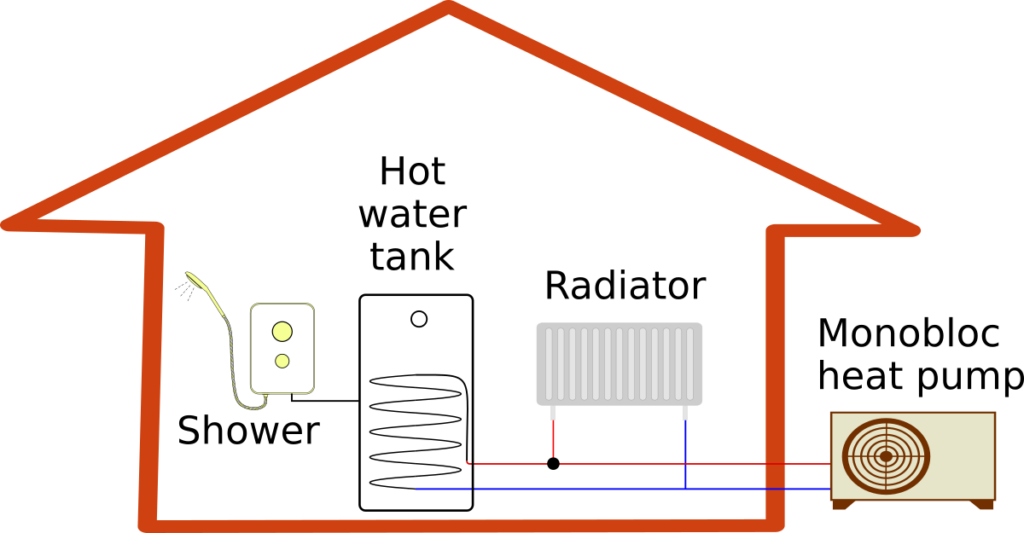
However, a split system has two segments: An indoor unit and an outdoor unit. The outdoor unit contains a fan while the indoor unit contains a heat exchanger. It’s also common for heat pump indoor units to have an integrated hot water tank:
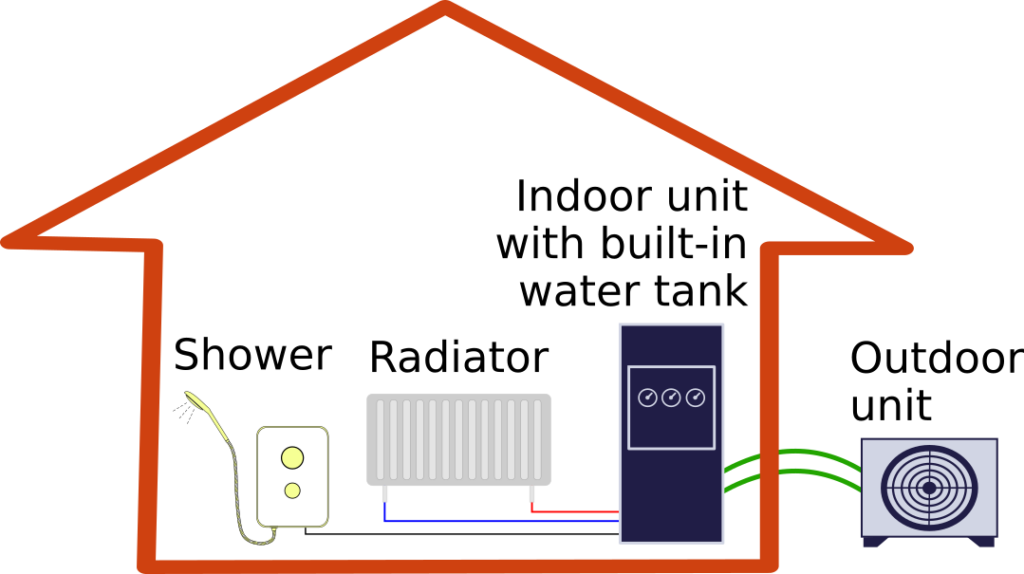
Each system has its own unique advantages. On the one hand, a monobloc system can make a simpler retrofit replacement for an oil or gas boiler. Plus, monobloc units have no refrigerant lines, making their installation simpler in most cases.
On the other hand, split systems allow for more flexibility in the installation layout. In particular, the outdoor unit of a split system can be installed a much farther from your home than a monobloc air-source heat pump.
Overall, it’s not worth getting hung up about the difference between monobloc and split systems. Differences in performance between the two kinds are small, and any reputable installer can advise on the best air-source heat pump layout for your needs. Instead, it’s better to focus on getting a high quality heat pump brand, a reputable installer, and plenty of insulation for your home.
Can heat air-source heat pumps work with radiators?
While radiators are most powerful at high temperatures, heat pumps produce heat most efficiently at low temperatures. So a heat pump is not always a simple drop-in replacement for an oil or gas boiler.
But there are ways to make a heat pump work well with radiators:
Super-insulate your home: With enough insulation, even a few lukewarm radiators may be enough to keep your home warm. This way, you may be able to simply drop a small heat pump in as a replacement for your oil or gas boiler. And running costs will be very low.
Get a radiator upgrade: Modern aluminium radiators pump out more heat than traditional steel radiators of the same size. Plus, bigger radiators let you extract more heat, even from lukewarm water.
Get extra radiators: Even one or two extra radiators can make all the difference.
Use a high-temperature heat pump: Some manufacturers now offer air-source heat pumps with flow temperatures up to 80 °C. These high-temperature models can be a drop-in replacement for oil and gas boilers. However, high-temperature heat pumps use more electricity than standard heat pumps. So keep this option as a last resort.
Do air-source heat pumps work with underfloor heating?
Air-source heat pumps and underfloor heating are a great match. This is because both heat pumps and underfloor heating work best at low flow temperatures. Indeed, underfloor heating is the key to unlocking the super-high efficiency that heat pumps are capable of when running at a flow temperature of only 30 or 35 °C. So if you currently have underfloor heating and want to install a heat pump, then you’re in luck!
On the other hand, adding underfloor heating to an older house takes a lot of work. Floors need to be removed meaning disruption, time, and expense. But underfloor heating can be well worth it. Besides maximising heat pump efficiency, installing underfloor heating:
- Saves space by eliminating radiators
- Is an opportunity to install underfloor insulation
- Increases comfort with warm floors
- Means floors dry quickly after washing

Air-Source Heat Pumps vs Ground-Source Heat Pumps
Ground-source heat pumps work a lot like air-source heat pumps. The difference is exactly what it sounds like: ground source heat pump extract warmth from the ground outside, rather than the air. This has a couple of implications.
First, ground-source heat pumps need a system of pipes to extract warmth from the ground. These pipes can be laid in a horizontal “bed” around 1 m underground (horizontal loop) or a vertical borehole (vertical loop).
Either way, the pipe network means ground-source heat pumps are much more expensive than air source heat pumps (typically €7,000 extra). It also means you can only install ground-source heat pumps in locations with suitable geology.
Secondly, ground-source heat pumps do away with the need for an outdoor fan unit. This eliminates any possibility of fan noise problems.
Finally, ground-source heat pumps are usually more efficient than air-source heat pumps. This is because the ground has a more stable temperature than the air. In countries with very cold winters, the difference in efficiency between ground-source and air-source can be substantial. But with Ireland’s mild oceanic climate, the difference in efficiency between ground-source and air-source heat pumps is small.
Air source heat pumps and the environment: CO2
An air-source heat pump produces no harmful emissions at the point of use. But we should consider the impact of generating electricity to power the heat pump.
The Energy in Ireland Report states that 296 grams of CO2, were released for every kWh of electricity used in Ireland in 2020. Assuming a typical heat pump efficiency of 400%, that means 740 kg of CO2 will be released to provide 10,000 units of heat to an Irish home, using an air-source heat pump. The table below provides comparisons with rival heating systems:
| Heating system | Efficiency | CO2 to deliver 10,000 kWh of heat | |
| Air-source heat pump | 400 % | 740 kg | |
| Electric Radiators/Infrared | 100% | 2,960 kg | |
| Oil boiler (condensing) | 95 % | 2,631 kg | |
| Oil boiler (non-condensing) | 80 % | 3,125 kg | |
| Gas boiler (condensing) | 95 % | 1,894 kg | |
| Gas boiler (non-condensing) | 80 % | 2,250 kg |
The results are clear: Heat pumps result in far lower carbon dioxide release for the same amount of heating, compared to electric heaters and oil/gas boilers. And the difference is only likely to get wider, as wind and solar continue to replace fossil fuels in Ireland’s electricity supply.

Air-source heat pumps and the environment: Refrigerant gases
Carbon dioxide is not the only gas that can be released from heating systems. Indeed, many heat pumps contain refrigerant gases with potent environmental impacts. The popular R-410a is 2,088 times more potent as a greenhouse gas than carbon dioxide, for example.
The worst case scenario for the environment would be all the R-410a escaping from an air-source heat pump. In this case, the climate impact would be equivalent to 3 tonnes of CO2 (assuming the heat pump contains 1.5 kilograms of R-410a). This amount is roughly comparable to the emissions of an oil boiler running for one year. Over the decades-long lifetime of a heating system though, heat pumps are still by far the better option for the environment.
On the other hand, many newer heat pumps use natural refrigerants with minimal environmental impact, like R-744 and R-290. So if you want to minimise your environmental impact then make sure to choose a natural refrigerant. But even an R-410a heat pump is a great improvement over an oil or gas boiler when it comes to global warming impact.